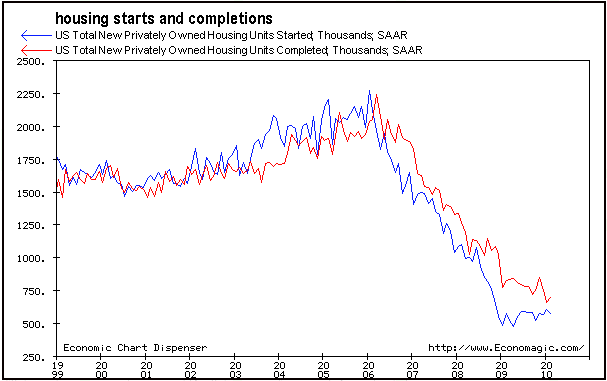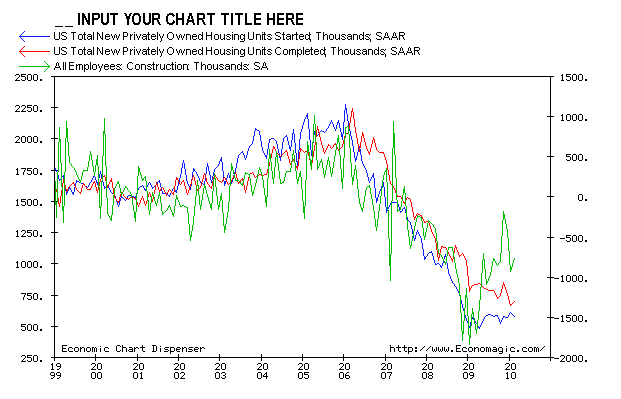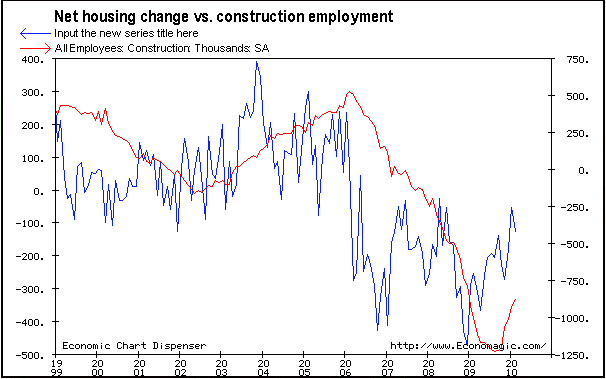




Nonfarm payroll employment increased by 162,000 in March, and the unemployment rate held at 9.7 percent, the U.S. Bureau of Labor Statistics reported today. Temporary help services and health care continued to add jobs over the month.
Employment in federal government also rose, reflecting the hiring of temporary
workers for Census 2010. Employment continued to decline in financial activi-
ties and in information.

Now -- that leads to the final question: when will the jobs come back? In order for that to happen we need to see at least one quarter of a positive GDP and probably two. That means the soonest we can expect a drop in the unemployment rate would be the a few months from now and that is only under the rosiest of scenarios. The most likely possibility is it won't be until the end of the first quarter of next year before we start to see a ticking down (and that assumes a stronger rate of growth than I think is going to happen).
 Starting with the big picture, prices are in a clear uptrend, although they are approaching important technical support. The EMAs are in a bullish configuration, but the 10 and 20 day EMAs have recently turned lower. Prices are also below the 10 and 20 day EMA, which will pull prices lower going forward. The MACD is about to give a sell-signal. Also note the degree to which money has flowed out of the security (the A/D line at the bottom).
Starting with the big picture, prices are in a clear uptrend, although they are approaching important technical support. The EMAs are in a bullish configuration, but the 10 and 20 day EMAs have recently turned lower. Prices are also below the 10 and 20 day EMA, which will pull prices lower going forward. The MACD is about to give a sell-signal. Also note the degree to which money has flowed out of the security (the A/D line at the bottom). 



Nonfarm payroll employment increased by 162,000 in March, and the unemployment rate held at 9.7 percent, the U.S. Bureau of Labor Statistics reported today. Temporary help services and health care continued to add jobs over the month.
Employment in federal government also rose, reflecting the hiring of temporary
workers for Census 2010. Employment continued to decline in financial activi-
ties and in information.

Fewer Americans filed claims for jobless benefits last week, bringing the average over the past month to the lowest level since 2008, as the economic recovery prompted companies to retain staff.Initial jobless applications declined by 6,000 to 439,000 in the week ended March 27, in line with the median forecast of economists surveyed by Bloomberg News, Labor Department figures showed today in Washington. The number of people receiving unemployment insurance was little changed, while those getting extended benefits rose.
Employers are slowing job cuts, a sign of confidence, as the U.S. emerges from the worst recession since the 1930s. Sustained employment gains are needed to boost consumer spending, which accounts for about 70 percent of the economy.
“We are turning a corner in the labor market,” said Julia Coronado, a senior U.S. economist at BNP Paribas in New York, who had forecast a decline in the weekly jobless claims. “Businesses are gradually starting to have more confidence in the recovery.”
.....
Employers announced fewer job cuts in March than a year earlier, another report showed today. Planned firings fell 55 percent last month to 67,611 from 150,411 a year earlier, according to data collected by the job placement firm Challenger, Gray & Christmas Inc. Announcements increased from February’s three-year low of 42,090.
Let's go to the data:
A few weeks ago, I expressed concern about the initial claims numbers, largely because they seemed to be unable to continue to move lower. Over the last several weeks we've seen those numbers drop a bit which eases my mind. However, a continued move lower to the 400,000 range is really needed right now.
The job cut number has been pretty low for awhile now and points to continued improvement in the jobs market.
The reported rise in retail sales this morning had the media had in a full throated bull chorale...But as usual it’s all hype, little substance. A dead cat bounce is not a recovery. The “recovery” the pundits are talking about is little more than a semantic game. Bernanke sounds more like Chauncey Gardener every day. If this is recovery it must be just like the “recovery” that took place in the 4th quarter of 1929 and first quarter of 1930.Adler's piece was quickly picked up by the usual suspects, as proof that the Recovery was illusory. Now, I respect Lee Adler a lot, and in particular he was one of few non-permabears who called the September-October 2008 crash ahead of time. But the fact is that state and withholding tax collections lag. You have to have the recovery and the hiring first, before people pay taxes on their new jobs and revenues!
The two-year slide in tax collections that opened a $196 billion gap in U.S. state budgets has stopped, easing pressure on credit ratings and giving leeway to lawmakers as they craft spending plans for next year.Although getting recent, accurate state tax receipt data on the internet is fiendishly difficult, it nevertheless appears that once again, Mish unintentionally bottom-ticked an economic indicator a month ago when he highlighted the shortfall in November 2009 state revenues.
The 15 largest states by population forecast a 3.9 percent gain in tax revenue in fiscal 2011, budget documents show. The 50 states on average may increase collections by about 3.5 percent, the first time in two years the figure is expected to grow, said Mark Zandi, chief economist at Moody’s Economy.com,
....
Combined state and local tax collections climbed to $360.1 billion during the final three months of 2009 , the first year- over-year gain in five quarters and an almost 1 percent boost from the same period in 2008, according to the agency.
....
“We’ve seen the worst,” said Philip Condon, who oversees about $9.4 billion in municipal bonds for DWS Investments in Boston. “While it may not be great, it’s getting better.”
• "Certain markets served have increased by 50 percent in new customer orders, while other markets are not as strong." (Miscellaneous Manufacturing)As to employment, the ISM said:
• "Business levels continue to be strong coming out of the Chinese New Year. First quarter will be our best since 2000." (Machinery)
• "Business is steady and prospects are good for Q2." (Food, Beverage & Tobacco Products)
• "After-market sales are improving as more vehicles require maintenance." (Transportation Equipment)
• "There is a serious shortage of basic electronic components, and lead times are becoming a problem. We are also seeing dramatic price increases." (Computer & Electronic Products)
This is the fourth consecutive month of growth in manufacturing employment. An Employment Index above 49.8 percent, over time, is generally consistent with an increase in the Bureau of Labor Statistics (BLS) data on manufacturing employment.Although it would have been nicer had the employment index increased, showing faster growth, this is an almost perfect report, and its leading component adds to the likelihood that March's Index of Leading Indicators number will be quite good, meaning continued growth in the next 3-6 months.









Nonfarm private employment decreased 23,000 from February to March on a seasonally adjusted basis, according to the ADP National Employment Report®. The estimated change of employment from January 2010 to February 2010 was revised down slightly, from a decline of 20,000 to a decline of 24,000.
The March employment decline was the smallest since employment began falling in February of 2008. Yet, the lack of improvement in employment from February to March is consistent with the pause in the decline of initial unemployment claims that occurred during the winter.

Companies are still hesitant to add workers until they see sustained sales gains and are convinced the economic recovery has taken hold. Economists surveyed by Bloomberg News anticipate the government’s report April 2 will show payrolls increased by 184,000, in part due to temporary hiring by the federal government to conduct the 2010 census and because of better weather compared with February.



When workers become more efficient, it's normally a good thing. But lately, it has acted as a powerful brake on job creation. And the question of whether the recent surge in productivity has run its course is the key to whether job growth is finally poised to take off.One of the great surprises of the economic downturn that began 27 months ago is this: Businesses are producing only 3 percent fewer goods and services than they were at the end of 2007, yet Americans are working nearly 10 percent fewer hours because of a mix of layoffs and cutbacks in the workweek.
That means high-level gains in productivity -- which in the long run is the key to a higher standard of living but in the short run contributes to sky-high unemployment. So long as employers can squeeze dramatically higher output from every worker, they won't need to hire again despite the growing economy.
.....
Businesses have certainly not been investing in new equipment that might enable workers to be more efficient -- capital expenditures plummeted during the recession and are rebounding slowly. And the structural shifts occurring in the economy are so profound that one would expect productivity to be lower, rather than higher, as people need new training to work in parts of the economy that are growing, such as exports and the clean-energy sector.
.....
Instead companies squeezed more work out of remaining employees, accounting for a 3.8 percent boost in worker productivity in 2009, the best in seven years. Which raises the question: Why couldn't companies have achieved those gains back when the economy was in better shape? The answer to that may lie on the other side of the equation -- employees.
Workers were in a panic of their own in 2009. Fearful of losing their jobs, people seem to have become more willing to stretch themselves to the limit to get more done in any given hour of work. And they have been tolerant of furloughs and cutbacks in hours, which in better times would drive them to find a new employer. This has given companies the leeway to cut back without the fear of losing valuable employees for good.
First, consider charts:
The percent change in overall business output since the beginning of 2009 has been on the rebound, turning positive in about mid-2009.
At the same time we say an overall increase in output, we also saw a big spike in the output per hour of person.
So - why is this happening now? I think the last paragraph nailed the real reason: panic. People were looking around themselves and noticing that companies were really cutting back. Then they saw the national unemployment numbers and became extremely grateful for having a job. At this point, employers realized they could really push people hard and expect little to no blow back (people leaving/come type of confrontation etc..).
What's important to note is this set of circumstances can't be duplicated; they are unique to the economy as it currently exists. When we start to see less labor market slack, more consecutive periods of growth and lower unemployment, this situation will slowly disappear.





Personal income increased $1.2 billion, or less than 0.1 percent, and disposable personal income (DPI) increased $1.6 billion, or less than 0.1 percent, in February, according to the Bureau of Economic Analysis. Personal consumption expenditures (PCE) increased $34.7 billion, or 0.3 percent. In January, personal income increased $30.4 billion, or 0.3 percent, DPI decreased $26.0 billion, or 0.2 percent, and PCE increased $38.5 billion, or 0.4 percent, based on revised estimates.
Real disposable income increased less than 0.1 percent in February, in contrast to a decrease of 0.4 percent in January. Real PCE increased 0.3 percent, compared with an increase of 0.2 percent.
 Total compensation has been increasing since September.
Total compensation has been increasing since September.
 With the exception of November, total service compensation has been increasing since July of last year. This sector accounts for 51% of total compensation.
With the exception of November, total service compensation has been increasing since July of last year. This sector accounts for 51% of total compensation.
 Real PCEs have been increasing since September.
Real PCEs have been increasing since September. The largest component of expenditures is on services, which account for 65.66% of all expenditures. With the exception of November, this category of expenditures have been increasing since last July.
The largest component of expenditures is on services, which account for 65.66% of all expenditures. With the exception of November, this category of expenditures have been increasing since last July. Expenditures on non-durable goods (which account for 22.21% of all expenditures) rose steadily until December, but have risen for the two months since December.
Expenditures on non-durable goods (which account for 22.21% of all expenditures) rose steadily until December, but have risen for the two months since December.








